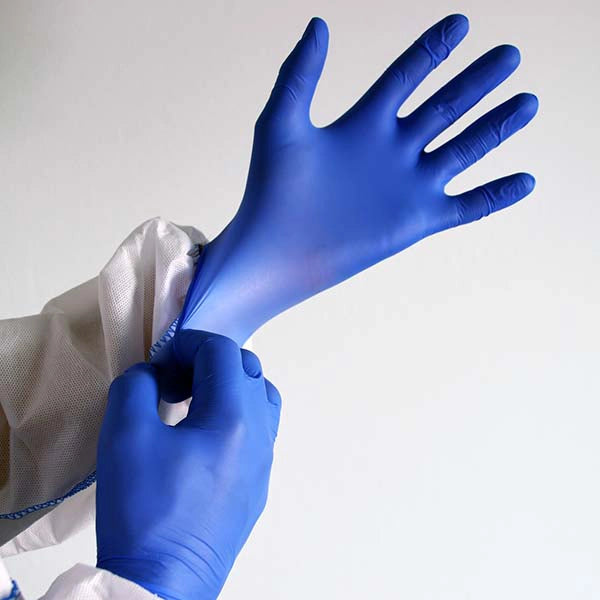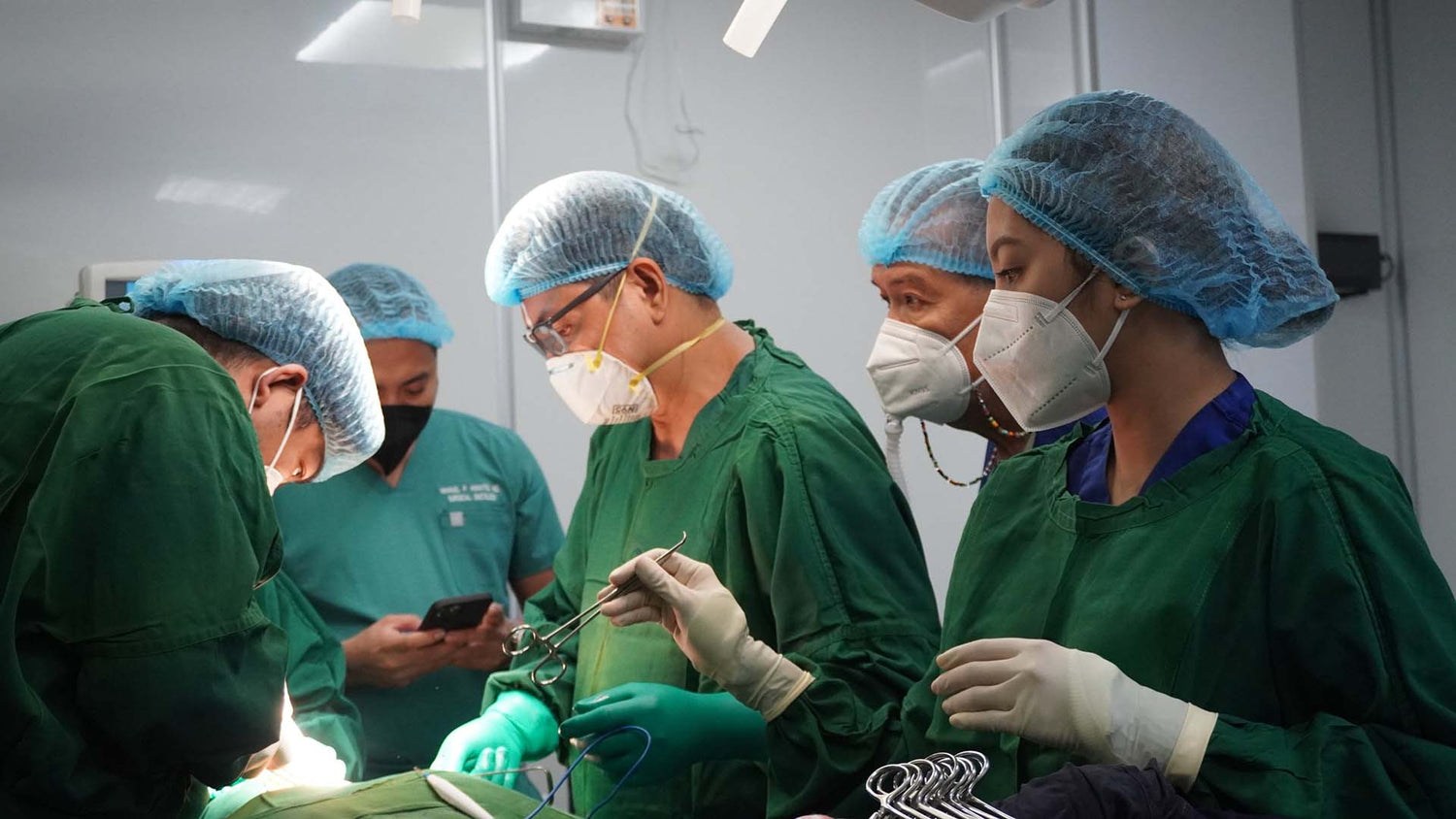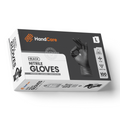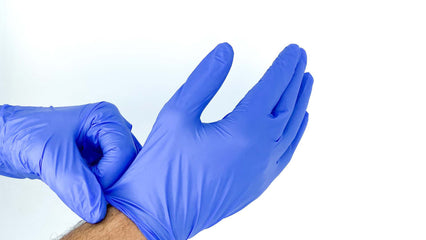Wearing disposable gloves has become a common practice in various industries, including healthcare, dentistry, food services, and more. Gloves are also used in industrial, automotive, transportation, sanitation, and other industries.
Gloves provide a protective barrier, helping to safeguard both the wearer and those around them from contamination, accidents, injuries, and health issues. However, not all gloves are created equal and designed for every purpose.
Different gloves serve different purposes, and there are many different gloves to choose from based on the application, materials, purpose, tasks, and industry you are working in.
If you are browsing for gloves, you may be curious about the differences between sterile medical gloves and non-sterile disposable gloves. But what do they mean? Let’s differentiate and discuss medical vs non-sterile gloves in this guide.
What Does Sterile Mean?
Sterile refers to an environment or object that is completely free of all microorganisms, including bacteria, viruses, fungi, and spores. In the context of gloves, sterile gloves are those that have been treated and packaged in a way that ensures they are free from any living microorganisms. This level of cleanliness is crucial in medical and surgical settings where the introduction of any microbes could lead to infection or other complications.
👉 Shop Medical Nitrile Gloves and save up to 50% today
Sterile gloves are typically individually packaged and subjected to strict sterilization processes, such as autoclaving, to meet the highest standards of hygiene and safety.
Sterile vs Non Sterile Gloves: Differences and Complete Overview
Wearing disposable gloves is mandatory in the healthcare, medical, and dental industries. When you are searching for disposable gloves, you might have encountered both medical or dental sterile gloves and non-sterile gloves. These two are the main types of disposable gloves used in medical environments.
Medical disposable gloves and non-sterile disposable gloves look the same. However, the main difference between medical vs. non-sterile gloves is the mandated Food and Drug Administration’s Standard Assurance Level (SAL) sterilization process enforced on medical gloves. Hence, sterile medical gloves are typically used in surgical procedures.
What Are Sterile Gloves?
Sterile gloves are disposable gloves that have been subjected to a rigorous sterilization process enforced by the FDA. Medical-grade gloves are required in both the medical and dental industries. The goal of sterilizing gloves is to minimize the risk of infection, contamination, or the spread of pathogens during medical procedures or applications.
Sterile gloves are meticulously manufactured to meet stringent cleanliness standards. They are typically used in medical settings, laboratories, and other environments where maintaining a sterile field is paramount.
What Are Sterile Gloves Used For:
Sterile gloves provide a barrier between medical personnel and their patients. They are indispensable during surgical procedures, wound care, and any other situation where preventing contamination is critical. The gloves help to protect both the patient and staff members against bacteria and other microorganisms.
Sterile medical gloves are used in most invasive medical and dental operations and procedures. Here are where medical gloves are typically used in the medical and dental field:
- Oral, periodontal, or endodontic surgeries
- Performing dialysis
- Catheter insertion and care
- Delivering babies
- Changing and applying dressings for operation or surgical wounds
- Conductive invasive medical operation procedures
- Inserting central intravenous lines or care
- Holding sterile surgical equipment and tools
- Chemotherapy
Sterile Gloves Pricing:
When it comes to pricing sterile vs non-sterile gloves - sterile will almost always be more expensive. The production of sterile vs non-sterile gloves takes a lot longer with added steps and processes that cost both time and money - which is later reflected in the price.
In addition to a rigorous production process, sterile surgical gloves must be stored in individually wrapped packing to ensure their sterility - making them generally more expensive than non-sterile gloves. While they are slightly more expensive, they make medical examinations much safer to perform.
Sterile Gloves Packaging:
One of the fastest ways to know your gloves are sterile is individually wrapped packing.
To maintain their sterility, sterile gloves will always be packaged individually and handled with care, from the sterilization process to transportation, storage, and use during medical procedures.
Sterile Gloves Production Process:
To produce and manufacture sterile surgical gloves, gloves should be exposed to gamma waves. This ensures all the sterile disposable gloves are free from dangerous bacteria, germs, and viruses before use. The manufacturers should be able to produce or show a COI for validation and proof that the gloves underwent gamma waves.
Aside from exposure to gamma waves sterile technique, two sterilization methods are commonly used to sterilize medical gloves: autoclaving and ethylene oxide. In autoclaving, high-pressure steam and intense heat are used. While ethylene oxide gas is used to sterilize medical gloves.
Throughout the production process of sterile medical gloves, they are checked and examined for quality assurance. Sterile gloves should pass the stringent quality assessment tests, come with a Certificate of Analysis or COA, and be packed individually, transported, stored, and handled with utmost care.
Advantages of Sterile Gloves:
- The Highest Level of Sterility: when working in a medical environment a superior level of sterility makes procedures safer for both patients and healthcare professionals.
- Lower Risk of Infection: when it comes to sterile vs non-sterile gloves - sterile medical-grade gloves significantly reduce the risk of infection during patient care.
- Specialized Uses: perfect for surgeries, invasive procedures, and lab environments where maintaining a sterile site is crucial.
Disadvantages of Sterile Gloves:
- Higher Cost: expensive sterile gloves can quickly hike your costs up, especially when using multiple pairs per day.
- Limited General Use: while sterile disposable gloves are essential in many scenarios, they're less versatile when it comes to everyday tasks.
What Are Non-Sterile Gloves?
Non-sterile or clean gloves are made from the same materials as sterile surgical gloves. They are available in latex, vinyl, or nitrile. Like sterile gloves, a non-sterile glove can be used in a medical environment - however, they don't offer the same level of protection as sterile gloves. But what are non-sterile gloves, and are they really that different from sterile disposable gloves?
What Are Non Sterile Gloves Used For:
In general, non-sterile gloves are the same as sterile surgical gloves. The only difference is the high-level sterilization process that sterile medical gloves should pass.
Even though non-sterile gloves didn’t pass through gamma waves or other sterilization procedures, they can still be used in various healthcare settings and procedures. As long as the wearer is not exposed to any biological risks, bodily fluids, wastes, and other fluids, clean gloves can be used.
Non-sterile gloves are available in medical-grade or industrial grade.
Industrial grade non-sterile gloves can be used in procedures where the wearer is not exposed to any bodily fluids, blood, and pathogens such as:
- All non-surgical general dental procedures
- Administering injections
- Providing oral medications
- Taking pulse, temperature, and blood pressure
- Removing and replacing linens
- Patient transportation
- For medical grade non-sterile gloves, you can use them in the following situations:
- Cleaning and handling medical tools, equipment, and instruments
- Inserting and removing IVs
- Cleaning spills
- Removing drains and sutures
- Being in contact with blood, bodily fluids, and non-intact skin
- Dressing healing wound
- Removing urinary catheters
Non-Sterile Gloves Pricing:
Non-sterile gloves are generally more cost-effective than sterile gloves - however, they should never be used to replace sterile gloves in a sterile environment. The absence of stringent sterility requirements and individual packaging makes them considerably cheaper than sterile gloves.
Non-Sterile Gloves Packaging:
Unlike their sterile counterpart, non-sterile gloves are often packaged and sold in bulk containers and don't need to be stored in individual packaging.
Non-Sterile Gloves Production Process:
Manufacturers of non-sterile gloves are not sterilized or don’t undergo any high-level sterilization process during their production. However, it doesn’t mean your non-sterile glove isn't clean. Non-sterile gloves also have to pass the FDA’s standard assurance level to be considered safe for use - whether they're headed to a medical environment or not!
Advantages of Non-Sterile Gloves:
- Versatility: non-sterile disposable gloves can be used for non-surgical procedures and operations.
- Affordability: non-sterile gloves are more affordable than sterile medical gloves.
Disadvantages of Non-Sterile Gloves:
- Limited Sterility: non-sterile gloves cannot be used in a sterile environment - even in a pinch.
- Risk of Contamination: when using gloves in a medical environment, there is a higher risk of contamination than when using sterile gloves.
Factors to Consider in Choosing Between Sterile or Non-Sterile Gloves
Due to the sensitivity of procedures and operations in hospitals, dental practices, and other healthcare establishments, wearing the right type of gloves is mandatory. However, not all types of gloves are made the same. Here are a few things you need to consider when searching for the right type of gloves.
Material
There are three main types of materials used for disposable gloves, namely:
- Latex Gloves: These are the most affordable and accessible types of gloves. Latex gloves are comfortable to wear, durable, and stretchy. However, if you have latex allergies, skip latex gloves.
- Nitrile Gloves: These gloves are more expensive but thinner, more comfortable, and stronger than latex gloves and vinyl gloves.
- Vinyl Gloves: These disposable gloves are thicker than latex gloves and nitrile gloves. Hence, they are not ideal for applications requiring precision and speed.
Comfort & Fit
Having comfortable fitting gloves is crucial in any medical, dental, or healthcare procedure. Loose or too-tight gloves will hinder movement, cause strain, and lead to accidents. Always order the right size of gloves.
Measure your hand size and select the right size next time you purchase disposable gloves.
Dexterity & Tensile Strength
Hand movement is important in medical operations, procedures, and tasks. The disposable gloves should never hinder your hand movement to prevent accidents.
Also, it is important that the gloves surgeons and medical practitioners wear should be stretchy, durable, and don't tear easily.
Sterile Medical vs. Non-Sterile Gloves
Sterile medical gloves are mandatory for medical and surgical use and procedures. Non-sterile disposable gloves are ideal for non-surgical procedures, household cleaning, food handling and preparation, and other applications with no transmission risk.
Powdered vs. Non-Powdered Gloves
Powdered gloves contain corn-starch coating. Hence, powdered disposable gloves are easier to wear and remove than non-powdered gloves. However, powdered gloves are not allowed in surgeries and patient examinations because they can cause irritation, inflammation, and other skin problems.
Also, powdered gloves are not ideal for food handling and healthcare industries. The powder can stick to food, ingredients, and skin.
Powdered gloves can be used in non-medical and non-food applications.
Why are Gloves Necessary in Medical Environments?
Sterile gloves are disposable gloves that have been subjected to a rigorous sterilization process enforced by the FDA. Sterilized medical-grade gloves are required in both the medical and dental industries. The goal of sterilizing gloves is to minimize the risk of infection, contamination, or the spread of pathogens during medical procedures or applications.
Non-sterile gloves are also used in medical settings - however, where the risk of contamination is much lower. Medical gloves are included in the personal protective equipment required in the medical and dental industries. Doctors, dentists, nurses, lab technicians, and other workers in the healthcare industry are prone to coming in contact with bodily fluids like blood, urine, vomit, mucous membranes, saliva, and more - and both sterile and non-sterile gloves healthcare staff from contamination. These body fluids can contain pathogens that can cause various health problems and infections.
You can prevent direct contact with these pathogens by wearing medical disposable gloves. High-quality and durable gloves are designed to prevent your hands from touching other people’s bodily fluids, skin, surfaces, and objects, which can be contaminated.
Both medical grade glove types protect both healthcare workers and patients while in close contact, helping staff in a healthcare environment to remove the risks
Can I Use Non Sterile Gloves for Food?
Yes, you can use non-sterile gloves for handling food. Non-sterile gloves are commonly used in food preparation and service to maintain hygiene and prevent the spread of contaminants. These gloves provide a barrier between your hands and the food, reducing the risk of transferring bacteria, viruses, and other microorganisms.
While sterile gloves are essential in medical and surgical environments, they are not necessary for food handling. Non-sterile gloves are sufficient to meet food safety standards as long as they are made from food-safe materials and are used properly. It’s important to change gloves frequently, especially when switching between tasks, to prevent cross-contamination and ensure food safety.
Are Non-Sterile Gloves Still Safe?
Non-sterile gloves, while not subjected to the same sterilization process, are still safe and effective for many everyday tasks. They are commonly used in environments such as medical examinations, food handling, cleaning, and other low-risk activities where the likelihood of contamination is minimal. Non-sterile gloves are typically produced in large quantities and are not sterilized, but they are still manufactured under stringent quality control processes to ensure basic hygiene and protection.
For most non-surgical applications, non-sterile gloves provide sufficient safety by protecting against contaminants, chemicals, and bodily fluids. They are suitable for situations where a high level of sterility is not required, but hygiene and barrier protection are still important.
In summary, non-sterile gloves are safe for general use, as long as they are used appropriately in environments where sterility is not critical. If sterility is a priority, such as during surgeries, sterile gloves should be used to ensure maximum safety and infection control.
Final thoughts
Sterile medical gloves are typically used for surgical applications and not anywhere else. The main reason is its price. Sterile disposable gloves are required to pass guidelines and tests to be considered “sterile”. Then, strict packaging, handling, transport, storage, and use should be implemented to preserve their sterility. Therefore, they’re more expensive and not ideal for everyday use if you’re not conducting any critical medical, dental, or surgical procedures.
While non-sterile gloves are much more affordable and convenient to use.
Both sterile medical and non-sterile gloves provide protection and are used in different applications. It is best to understand what your tasks are to identify which is better for you, sterile medical gloves vs. non-sterile gloves.
Check Out High-Quality Gloves at gloves.com
After deciding which disposable gloves fit your needs, it is time to look for high-quality gloves. Go to gloves.com and check out our collection of durable disposable gloves. We have different types of disposable gloves made from different materials, available in sizes, and all from reputable brands in the industry.
Whether you are searching for sterile medical gloves or non-sterile gloves, powdered or not, you can find them here!
Sterile vs. Non-Sterile Gloves: Frequently Asked Questions
Why would you want non-sterile gloves?
Non-sterile gloves are commonly used in situations where the risk of infection is low, and the primary need is for barrier protection. They are more cost-effective than sterile gloves and are suitable for a wide range of tasks, including routine medical examinations, food handling, cleaning, and general use. Their affordability and accessibility make them ideal for everyday use in many non-surgical environments.
When should non-sterile gloves be used?
Non-sterile gloves should be used in situations where sterility is not a critical concern. These include routine patient exams, handling and preparing food, performing janitorial or maintenance tasks, and any other activities where basic hand protection is needed to prevent contamination and maintain hygiene. They are appropriate for general purposes where protecting the user and the environment from contaminants is necessary, but not to the stringent levels required in sterile environments.
What's the difference between sterile and clean gloves?
The main difference between sterile and clean gloves lies in their level of cleanliness and intended use. Sterile gloves are free from all microorganisms and are individually packaged to maintain sterility until use. They are used in surgical and other medical procedures where a sterile environment is crucial. Clean gloves, on the other hand, are not free from all microorganisms but are still free from visible dirt and debris. They are used for general purposes, including medical examinations, food handling, and everyday tasks where maintaining a high level of hygiene is important, but full sterility is not required.








